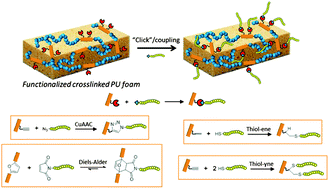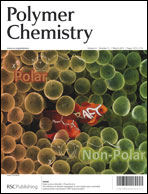For high-tech applications, polyurethane (PU) materials require additional surface properties and functionality, which can be achieved by incorporation of “clickable” groups in the PU structure, allowing for polymer post-modification via chemical coupling with desired molecules. Therefore, in this study, various “click” and coupling reactions, consisting of the copper(I) catalyzed Huisgen 1,3-dipolar alkyne–azide, thermally and photo-initiated thiol–ene/thiol–yne and Diels–Alder reactions, have been used for surface functionalization of PU foams. As a result of diffusional effects, the reaction rate was considerably depressed and thus, the reaction parameters, including the temperature and the concentration of reagents and the “click” compound, were optimized for each click/coupling approach to obtain high functionalization yields. As such, a kinetic comparison study of the different chemistries used was performed, using in situ FT-IR and offline 1H NMR methods. This work not only reveals kinetic trends but also compares promising and limiting aspects of the different click/coupling pathways employed, which is envisaged to be also useful for functionalizing other cross-linked polymeric materials.


 Please wait while we load your content...
Please wait while we load your content...